► Best compact executive car 2019
► New BMW 3-series vs all comers
► Is the 320d still the best car to get?
BMW is now in so many segments, from mammoth SUVs to mini EVs, it’s easy to forget its most familiar model is also its most important: no BMW sells more than the 3-series globally, and it remains the model that defines both the company and the premium D-segment. So there’s a lot riding on this latest seventh-generation G20 3-series.
This our first chance to test the new 3-series not only on UK roads, but also in the big-selling 320d trim and against its keenest competitors.
This test has to evaluate the new BMW 3-series against its traditional German rivals, the Mercedes C-Class and Audi A4 – both of which, according to Jato Dynamics, outsold the 3-series in Europe last year if you include all body styles. Then there’s the Alfa Giulia. It’s not a huge seller, but the Alfa’s a giant-killer when judged on its dynamics and looks, two core reasons to buy for 3-series loyalists.
But today’s drivers don’t all think along traditional lines. Buyers and user-choosers have more choice than ever, and given a 3-series-sized pot of cash some will head off in a different direction. That’s why we’re also testing the Jaguar E-Pace and BMW X2 compact SUVs, and throwing in a couple of curveball saloons: the Peugeot 508 and much larger Lexus ES.
Diverse, certainly, but all eight cars tested here cost between £36,439 and £39,495 before options, so they’re all contenders for your 3-series money.
Keep reading for the rest of our epic 3-series test, or check out these links below:
Group one: the endless struggle
It’s a war as old as war itself: BMW versus Mercedes versus Audi. Oh, and an Alfa that thinks it’s a BMW
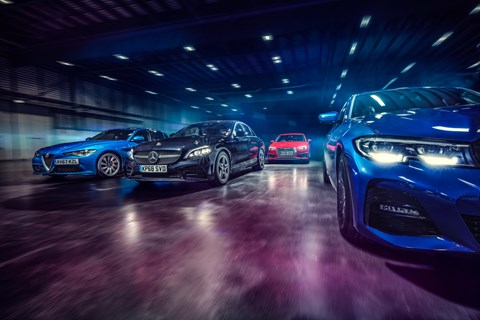
You won’t get confused, like you might with a new 911, because there’s no doubting this new 3-series is all-new. It looks, and is, a much bigger car.
Now based on BMW’s CLAR architecture as per 5- and 7-series, it’s 85mm longer (at 4709mm) and 16mm wider (1827mm). When I climb behind the driver’s seat, set for my 6ft 1in, my knees don’t rub the seatback like they do in everything else here bar the Lexus. Even the Peugeot – longer at 4750mm – has a shorter wheelbase and a little less rear space. The Alfa, Mercedes and Audi are all tighter in the back.
But because there’s now more aluminium in among the steel, the new 3-series is up to 55kg lighter than before. There are wider tracks, the new iDrive system, more efficient engines, generous equipment…
Our test car is in 320d trim with xDrive all-wheel drive. xDrive also brings the eight-speed automatic as standard, and a £3190 premium over rear-drive. All tallied, that’s £39,495 in range-topping, top-selling M Sport trim, £47,855 optioned up.
Other than incongruously cheap-looking Sensatec trim (actually far from cheap at £500), this is an impressive cabin crafted around driving. The lean, taut architecture looks like a geometry teacher snuck into the BMW design department, and I love the reference to old-school BMW in the tilt of the centre console towards the driver, and that the climate-control functions are easily found on buttons set far up the dash.
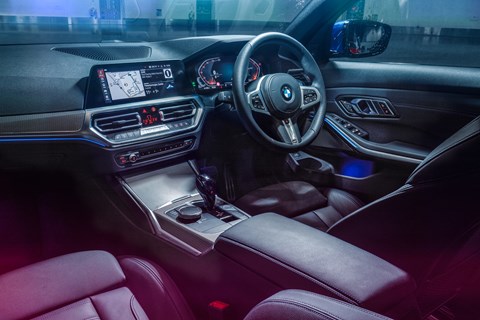
But the stand-out is the infotainment – a 10.3-inch display that can be controlled with the iDrive rotary controller, but also via the touchscreen, steering-wheel controls, gesture control and voice control.
The low-set leather driver’s seat is perfection, with meaty bolstering around your middle, and although there’s very little give in the squab, backrest and headrest, they’re long-distance comfortable.
There’s no doubting you’re in a four-cylinder turbodiesel at idle, but the clatter quickly evaporates once you’re running. Versus the old 3, mpg and CO2 improve at 49.6-52.3mpg and 118g/km, but performance is unchanged at 187bhp and 295lb ft. Throttle response is good, with generous muscle from middling speeds after fractional turbo lag, and the eight-speed auto flicks quickly between ratios. Of course the performance of a 320d won’t make you whoop, but there’s plenty for normal driving.
On 19-inch alloys with adaptive M Sport suspension, there’s some road noise, and the ride is definitely firm, more in the way it fusses over secondary bumps than in larger movements being abruptly curtailed. But combined with our car’s uprated four-piston brakes, which form part of the £2200 M Sport Plus pack, Michelin Pilot Sports and xDrive transmission, the payback is a chassis that’s a joy to drive. It pulls up quickly, has front grip so heroic that only a little chirrup says you’re at the limit, and reassures with precise and chunkily weighted steering, body movements always kept in check. It also feels so rear-biased it’s easy to forget all-wheel drive is working in the background. Even the steering seems mostly to avoid the stickiness that comes with front wheels having to both turn and drive. It’s definitely got point-to-point pace to upset more powerful machinery. But with xDrive and 320d power, this 3-series doesn’t feel as alive as the new 330i I drove recently. It’s very good, but if I was driving one cross-country to Wales it would be because I was heading there for a business meeting, not driving for the heck of it.
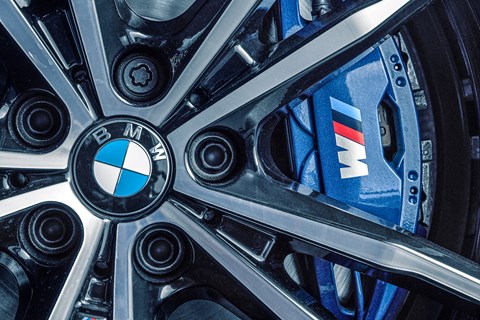
But if I owned the Alfa I’d be tempted to up sticks and move to a Welsh B-road. Alfa does diesel Giulias if you’re after precise powertrain and financial parity with a 320d, but the bad press currently depressing diesel sales might prompt you to consider the petrol-powered Veloce. At £38,260 it’s comparable to 320d pricing, but swaps the derv for a 2.0-litre blown petrol four like you’d find in a hot hatch. You get 295lb ft like the diesels, but a much stronger 276bhp, plus standard eight-speed auto and rear-wheel drive. There’s even a claim of 46.3mpg with your 5.7-second 0-62mph.
It’s a cut-price alternative to the 500bhp Alfa Quadrifoglio we rate so highly, and you can spec Veloce Ti trim and other visual treats to further the illusion. Nice, but unnecessary, as our car proves with its wolf-whistle body and still attractive 18s. If you can stretch to it, the £1950 Performance Pack is nigh-on essential. Adaptive dampers, limited-slip diff, paddles… it all contributes to our Giulia being so phenomenally good to drive.
Alfa gets it right from the off with gorgeous ribbed leather seats positioned down on the deck, bolsters hugging you like a Vespa pillion, and Ferrari references impossible to overlook: starter button on the wheel, a dash that drops low to wrap around circular air vents, and our car’s (optional) blade-like shift paddles fixed to the column, not the steering wheel.
After the 3’s locked-down suspension, the Alfa’s tuning philosophy is very different, with generous compliance and travel. The steering, too, has an almost shocking speed and lightness but also accuracy; it’s quite different from the BMW. It’s that echo of Ferrari again. At first I mistake the suspension travel for sloppiness and think the steering feels almost too rapid and pointy for the leisurely body movements, but within a few miles the Alfa feels deliciously light, nimble and unfazed by rough surfaces.
Its limits are high, but the Giulia trades the kind of brute-force feel of the 3-series for a more delicate nuance, so you’re reading and working with the surface more, feeling the body move, the tyres smearing a little over the surface and the rear arcing slightly under power. It’s driving as surfing, and when it all gels and you key into that rhythm it’s sublime. More’s the pity that the traction control cannot be disengaged, because there’s enough power to exploit that delicious balance. The four-cylinder turbo runs into its soft cut-out at surprisingly low revs, but it punches hard in the low- and mid-range, shifts gears in a finger-click and – considering the hardware – does a decent job of aural encouragement. Always quick, there are moments when the Veloce feels astonishingly rapid, particularly when firing from first to third coincides with corners you can almost take flat.
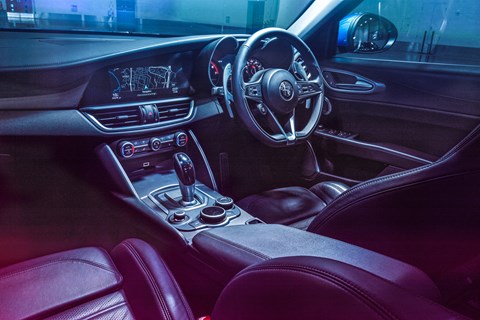
It’s an Alfa, so we’d be suspicious if there wasn’t ‘character’ here, and there is, particularly the calibration of Dynamic mode – tighter body control and weightier steering can be welcome on a mission, but an unnecessary pulse accompanies gearshifts, and backing off quickly at higher revs elicits a rude shunt. The brake pedal is also strangely long, although the four-piston set-up is excellent. Occasionally it just feels like the last 10 per cent of calibration magic is lacking.
There are other compromises, too: I struggled to actually sit behind myself, interior quality is patchy, the infotainment only average, there’s a whistle from the wing mirrors, hazard warning lights flash embarrassingly under hard braking and there are rogue ‘you’re-about-to-crash’ beeps in town. Character. But if dynamics are your priority, the Alfa Giulia Veloce is the ultimate driving machine in this test.
Our Mercedes is a more direct 320d rival. Now five years old, the C-Class was recently updated with more efficient engines and capacitive switches
on the steering wheel. Ours arrives dressed as a C220d AMG Line, which means AMG bumpers and skirts, and a 1950cc turbodiesel that promises 191bhp with 61.4mpg. A base £39,160 is tickled to £45,515, mostly thanks to Premium and Driving Assistance packs.
The C-Class looks a bit meek on 18-inch alloys, and less flashy inside with its sports seats upholstered in a mix of artico (convincing fake leather) bolsters and suede-like dinamica inserts, but they’re set suitably low and hold you well. There’s good room in the back too, but it’s strange that the rear bench is so much firmer than the front seats. It’s like being in church.
Other de-merits include a bulky, less focused look to the dash than the lean 3-series, and a far less neatly integrated infotainment screen. But ⊲ there’s a smart metal finish to the control interfaces, and the infotainment is extremely good, though our car’s 12.3-inch instrument cluster and Comand Online are bundled with the £2795 Premium pack.
The C-Class gets 15mm-lower sports suspension, so even on modest 18-inch Bridgestone Potenzas it rides like it’s got the hiccups, with vertical movements prematurely stifled. This ‘sportiness’ doesn’t lead to any great payback on a twisty road. At least you can delete the stiffer chassis. Performance is perfectly adequate, if a little unwilling – I wouldn’t have guessed at 6.9sec to 62mph and 149mph – and shifts are delivered with a lazy fuzz.
Everything the C220d does – bar its ride quality – it does to an acceptable level. But when you’re talking a £40k premium saloon up against this competition, it just can’t cut it.
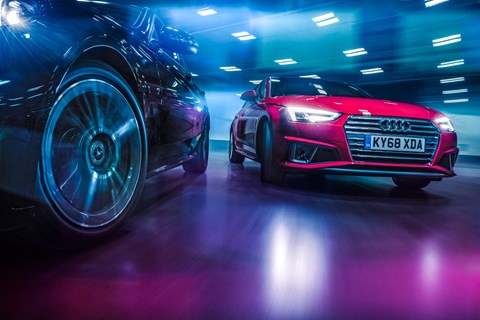
The Audi is better. It’s a 40 TDI S-line S-tronic, which Google Translate says is a 2.0 TDI in the sportiest trim with a dual-clutch gearbox. It costs a reasonable-in-this-company £36,445, topped to £42,105 mainly with the £1395 Technology pack, electric memory and nappa leather for the S-line sports seats, topping off an interior that’s minimal but not austere. Tight shutlines, richly textured leather, alcantara and brushed metal, crisp graphics – it’s like twisting a camera’s focus ring to make everything pin-sharp. It scores highly for usability too, with mostly intuitive infotainment and comfortable seats, plus ample space for rear-seat passengers and a useful 480-litre boot.
With only its front wheels driven, the A4 is the second lightest car here at 1480kg (behind the 1429kg Alfa), and fields an on-point 187bhp/295lb ft, 50-ish mpg and 120g/km. It pulls strongly from 1800rpm, and always feels flexible, partly thanks to a seven-speed dual-clutch auto with quick shifts and ratios that keep up your momentum.
The A4 also drives very well. Corners are strung together with more finesse than the Mercedes, thanks to crisp turn-in, responsive handling and steering that has a natural feel and accuracy, with a more leisurely ratio than rivals. Shame, then, that road noise from its 19-inch Contis and a choppy ride on fixed dampers knock its score; Audi offers adaptive dampers for £600, or no-cost Comfort suspension on S-lines.
With a cushier ride, the Audi’s interior build, infotainment and spacious rear quarters might displace the Alfa for those who put such things high on the list (and many will), but the 320d is still the most complete car of these traditional premium saloons. Over the page, we’ll see how the BMW fares against a new generation of rivals.
Group two: the SUV uprising
The prices of this new generation of high-rise, sporty 4x4s put them firmly in 3-series territory
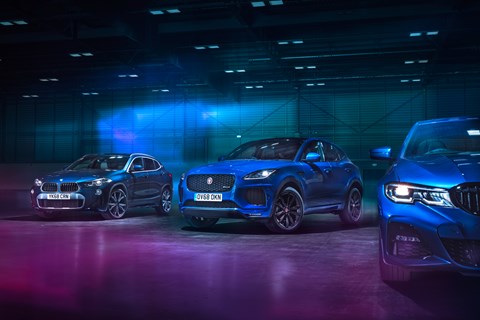
The 3-series is the obvious choice for good reason, but its sheer ubiquity will encourage some to consider a compact SUV instead. Stay loyal to BMW and that means the X2 xDrive 20d M Sport, closest on price at £38,150, a tempting £1345 cheaper than our like-for-like 3-series – at 4630mm long it’s smaller than both X1 and X3, but splits them on price.
Climb from a 320d up into an X2 and it’s like being bumped from business class. There are analogue dials, a flabbier look to the instrument panel, grainier leather, flimsier switchgear and older iDrive infotainment. The X2’s been on sale just a year but it’s like someone’s put a 10-year-old X5 interior in here by mistake. On the plus side, there’s a rear bench with enough room for large adults, and the 470-litre boot is just 10 litres shy of the 320d’s despite a body that’s easier to slot into parking spaces.
The X2’s UKL2 platform is related to the X1 and Mini Countryman, not the 3-series. Hence the engines are mounted transversely and entry-level versions are front-driven. Power and torque are identical to the 320d, but weight, performance and economy are all worse. Indeed, this is an inferior drive to the 3-series in every respect. Larger 20-inch rubber induces extra road noise, more turbodiesel clatter seeps into the cabin, and there’s extra wind noise too. The ride is lumpier, and the lag before bodyroll is checked gives you the fear when cornering a bit hot.
It’s not all moans. Performance is perfectly acceptable for typical driving, with a perky whoosh of boost in the mid-range, the gearbox is very good, and quickly responsive steering imbues energy. It grips well too, plus you can unlock a rear-biased secret level if you work the X2 like Starbucks is closing. But good grief, don’t actually buy the thing. A 3-series is miles better.
Jaguar’s XE has dynamically troubled the 3-series for the last few years. A refreshed version is imminent and we’ll test it soon, but it’ll probably
unjustly languish in showrooms while the E-Pace goes great guns. It’s another compact SUV you might pick instead of a 3-series.
The E-Pace is 123mm taller than the X2 and 51mm longer but costs a little less, starting from £37,870 in 178bhp turbodiesel/auto/all-wheel-drive trim. It shares the just-replaced Range Rover Evoque’s platform, and like the Evoque is heavy: 1831kg kerbweight versus the X2’s 1675kg. Again the SUV tailspin knocks all the important figures.
You sit higher in E-Pace than X2, but the driver’s seat hunkers low for a sportier sensation reinforced by a dash inspired by the F-Type’s. It’s a shame some very poor plastics have crept into some high places and that the infotainment – while functional – can’t compete with either BMW. There’s decent space in the rear, but both the X2 and 320d better the 425-litre boot.
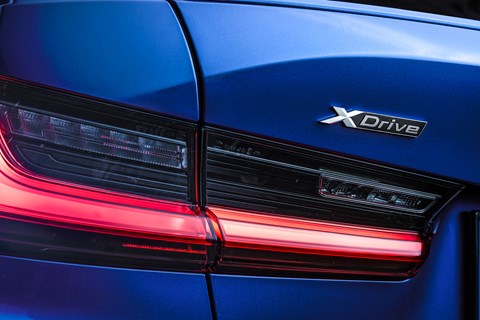
Despite also wearing 20-inch rubber, the E-Pace suffers less road noise than the X2, and its ride – on adaptive dampers – is better, though it’s still quite niggly in town, and at speed big vertical movements are sternly checked on trickier B-roads. It does feel more fluid though.
The Ingenium 2.0-litre diesel isn’t particularly smooth or quiet, but there’s a decent slug of torque low down, pacey, precise and mid-weighted steering for a nimble feel, and the nine-speed auto responds quickly to paddleshift commands, though it’s sometimes a little ponderous in auto.
This car feels less dynamic than the last E-Pace I drove, partly because it’s on all-season tyres, partly because the sportier Active Driveline all-wheel drive can only be combined with top-spec diesel and petrols, not our mid-ranking diesel. The front end throws in the towel more easily than I remember, and there’s no real sense of rear bias, just grip and then a neutral, understeery slip. The outgoing XE is a much better drive, so too the new 3-series.
Usually we test SUVs in isolation or in the context of direct rivals, but to drive these cars back-to-back with similarly priced saloons is to realise the huge compromises they entail. These crossovers weigh more, they can’t take you as far on a gallon of fuel and they’re much less enjoyable to drive than lighter, lower-slung models. For what? So buyers can sit up high and not go off-road? Honestly, it’s inexplicable. Just buy the obvious car.
Group three: the free radicals
Serious temptation from Peugeot and Lexus
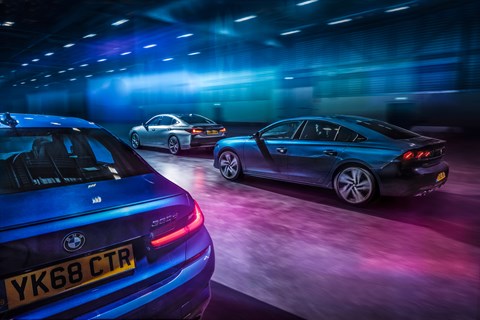
It’s hard to imagine Dragons’ Den backing a new posh saloon car pitched at the Germans. The sector’s static, SUVs are booming, everyone wants a BMW, Merc or Audi… The hapless execs would find themselves in a bloodbath cruelly prolonged for viewer amusement, their humiliation halted after the sweaty mental arithmetic becomes too embarrassing to watch.
Thankfully for us, some companies are still brave enough to offer non-SUV alternatives to the predictable 3-series, and because they know competition is fierce they make sure there are some damn good reasons to buy. Two of the latest to stick their headlights above the parapet hail from Lexus and Peugeot.
The Lexus ES has never been sold here before, but it’s now into its seventh generation. Based on the front-wheel-drive GA-K architecture, this one effectively replaces the rear-wheel-drive GS in the UK.
This is a substantially larger vehicle than the 3-series, and at 4975mm long it’s actually longer than a 5-series. No other car in this test provides so much space behind the driver, and popping the bootlid isn’t so much like opening a luggage compartment as accidentally opening a cargo bay in the International Space Station. I swear the boot’s larger than the car. Although it’s a much bigger car, on price and philosophy the ES absolutely merits inclusion: our F Sport sits at the centre of the three-tier range, is pitched as most dynamic of all, and lands bang in 320d M Sport territory at £38,150. Game on.
Long, low and pointy, fitted as standard with 19-inch alloys, the ES looks like an arrow about to be shot from an archer’s bow. It’s attractive and dramatic. Nice interior too. The 10-way sports seats are excellent, although they could go a little lower, and there are lovely materials – soft leather, shadow-chrome finishes, aluminium trim inserts inspired by shogun warriors’ katana swords.
Our car also gets the £4k Takumi pack, with 12.3-inch infotainment screen and a second-generation touchpad by the gearlever that highlights functions on the screen in response to finger movements. It’s okay to use while stationary, but still requires too much attention on the move.
Purely petrol models are sold elsewhere, but only the ES300h Hybrid reaches the UK. This has a 2.5-litre naturally-aspirated engine making ⊲ 176bhp/163lb ft, plus an e-motor with 118bhp/149lb ft, nickel-metal hydride battery and a CVT gearbox. The ES weighs at least 140kg more than the BMW, but promises a comparable 50-ish mpg.
The ES is a mixed drive. There’s vigorous acceleration out of junctions, it’s relaxing to slip around town silently when EV mode kicks in, and it makes a decent job of cornering at modest speeds. But this is not a car that indulges quicker progress, with howls of protest when accelerating to motorway speeds, a fuzzy relationship between paddleshift inputs and simulated gears, steering that feels artificial and lacks convincing feedback, and a front end that goes full Amphicar when driven more aggressively.
You’d perhaps forgive this if there were exceptional refinement at a gentler pace, but it’s nothing special. This might be because, along with larger wheels, F Sports get Adaptive Variable Suspension, not the Dynamic Control Shocks of its siblings. The default ride quality is a busy jiggle like mild airplane turbulence, but you can also select Sport S+ that simulates a space-shuttle breaking up on re-entry; I cannot imagine any scenario in which an ES driver will find this useful. There’s also a good deal of road noise, particularly on coarser surfaces.
Perhaps top-spec, more laid-back Takumi trim better suits the ES, but in F Sport it’s neither dynamic nor refined enough to stay in contention here.
The Peugeot 508 makes a more convincing alternative. Despite fielding top-spec GT trim, Peugeot has provided the cheapest car in this test at £36,439 as a 178bhp 2.0-litre turbodiesel. Even with £2.5k of options it’s still more affordable than a naked BMW, and chances are you’d only want the £575 metallic paint anyway.
Visually it gets off on the right foot with a design that recalls Peugeot’s greatest hits with an avant-garde, modernist twist – frameless door glass, coupe-like body, fantastic fangs slashing down from the headlights. It’s also a practical shape, with enough room for four 6ft-tall adults, and a hatchback rear that opens to reveal 487 litres of space and a best-on-test gong – yes, somehow more capacious than the Lexus.
The interior has a similar confidence to the exterior, with a look that brings to mind modernist architecture and makes its driver feel exceptionally intelligent – piano keys to select infotainment functions, carbonfibre-style trim that looks especially rich and textured as it catches the light, a centre console that rakes up like a flight deck.
The seatbacks are perhaps a little firm, and there’s some craziness with the extremely small steering wheel that obscures the iCockpit dash if adjusted for tall drivers and – sorry to be a stuck record – infotainment that can’t match the BMW. But you sense a design team pulling together here, confident in the esoteric look they’ve dreamt up, and executing it with a flourish, not a whimper. I like it.
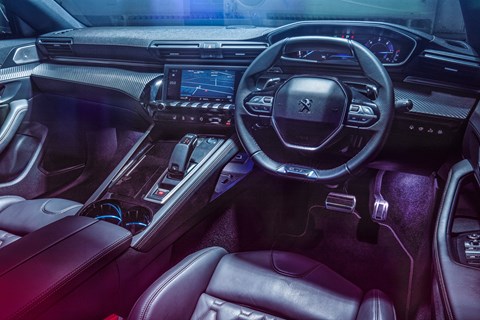
On 19-inch Pilot Sport 4s with adaptive dampers, the 508 turns in a highly satisfying drive. Perhaps it could smooth little secondary bumps better, but the overwhelming sensation is of good body control combined with lush suspension travel that compresses deeply and then just a little more, like sinking into a particularly comfortable bed. The turbodiesel gives easy, muscular performance from low revs, noise suppression is excellent, and gears shift with both speed and finesse.
Set the standard massage function to Cat Paw and you’ll feel soothed after driving across entire countries – I know, I drove from the Med to the Midlands in one.
The 508 GT’s easygoing nature belies a capable chassis when you crack on. Select Manual and you get stiffer – but not too stiff – dampers, and manual control of the gears. It grips hard, steers sweetly, stops well, shifts promptly and provides a generous bandwidth of performance no matter the relatively modest performance. There’s a fluency and effortlessness here that makes the 508 simultaneously relaxing, entertaining and really quite quick point-to-point in a manner that almost creeps up on you.
It is not the most dynamic car in this test, but the 508 strikes an extremely good compromise between the comfort and performance you’re most likely to appreciate in typical driving, and the ability to engage its driver over a challenging road. It’s a genuine contender for your 3-series money. ⊲
The verdict: time to break the BMW habit?
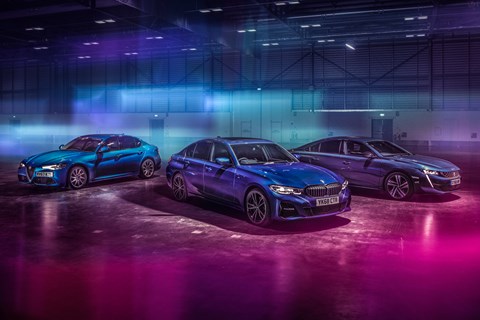
Of the eight hopefuls, three make it to the shortlist: BMW 320d M Sport, Peugeot 508 GT and Alfa Giulia Veloce.
Not long ago, Peugeot was floundering, but in the last few years it’s undergone a product-led renaissance, and the 508 continues that momentum. It is the best like-for-like alternative to the 3-series. The suave exterior and interior design channels French intellectual cool to make this a stylish, knowingly different choice, and you’ll find the 508 similarly practical to a 3-series too – if with less rear legroom but a larger boot. Many buyers will prefer that it focuses more towards comfort and refinement too, and yet it can still flow and entertain over a great road. That our GT-spec model is substantially cheaper than the 320d and requires almost no extra spend is another reason to break the German habit.
Alfa Romeo has undergone a similarly promising transformation in recent years, one spearheaded by the Giulia, its first rear-wheel-drive model since 75 production ended in 1992. It is not a rounded BMW substitute like the Peugeot, most notably in its tighter rear accommodation, but also some interior quality. What the Giulia does so well is tackle the 3-series’ core
attributes of design desirability and driving dynamics head-on. Design, well, you decide, but I’d say the Alfa is the more beautiful car. The Giulia Veloce also rides with more fluency and has the nerve to go toe-to-toe with the 3-series on dynamics then comes out on top. In Veloce spec with its 2.0-litre turbo petrol engine, it delivers both a lightness of touch and a level of driver engagement no matter your commitment that makes every drive a special occasion. If it’s all about the drive, the Giulia is your choice.
Perhaps predictably, the BMW 320d proves that it’s the Jack of all trades that manages to be pretty excellent at them all. Its interior is a masterclass in design desirability and driver-centric layout, and the G20’s growth spurt means even large adults aren’t cramped in the back. The latest iDrive infotainment is also great bounds ahead of the opposition, in terms of its glossy hardware and graphics, and in the flexibility of interaction it allows. Everything feels a bit frustrating after this.
In 320d M Sport xDrive trim, the BMW also drives extremely well, with a chassis that can squeeze every last drop of performance from the 2.0-litre turbodiesel and entertain in the process. Personally, I’d drop the xDrive as an unnecessary expense in a car with pretty modest performance, but there is no other car tested here able to maintain such a high batting average. For that reason, the BMW takes overall honours today, but don’t overlook the Peugeot and Alfa.
BMW 3-Series group test: specs and prices
BMW 320d xDrive M Sport
Price £39,495 (47,855 as tested)
Engine 1995cc 16v turbodiesel 4-cylinder,
187bhp @ 4000rpm, 295lb ft @ 1750rpm
Performance 6.9sec 0-62mph, 145mph, 49.6-52.3mpg, 118g/km CO2
Audi A4 40 TDI S Line
Price £36,445 (£42,105 as tested)
Engine 1968cc 16v turbodiesel 4-cylinder,
187bhp @ 3800rpm, 295lb ft @ 1750rpm
Performance 7.7sec 0-62mph, 150mph, 47.9-51.4mpg, 120g/km CO2
Mercedes-Benz C220d AMG Line
Price £39,160 (£45,515 as tested)
Engine 1950cc 16v turbodiesel 4-cylinder,
191bhp @ 3800rpm, 295lb ft @ 1600rpm
Performance 6.9sec 0-62mph, 149mph, 61.4mpg, 117g/km CO2
Alfa Romeo Giulia Veloce
Price £38,260 (£43,240 as tested)
Engine 1995cc 16v turbo 4-cylinder, 276bhp @ 5250rpm, 295lb ft @ 1750rpm
Performance 5.7sec 0-62mph, 149mph, 46.3mpg, 141g/km CO2
BMW X2 xDrive 20d M Sport
Price £38,150 (£44,525 as tested)
Engine 1995cc 16v turbodiesel four-cylinder, 187bhp @ 4000rpm, 295lb ft @ 1750rpm
Performance 7.7sec 0-62mph, 137mph, 45.6-48.7mpg, 124g/km CO2
Jaguar E-Pace 180PS
Diesel R-Dynamic S
Price £37,870 (£45,745 as tested)
Engine 1999cc 16v turbodiesel four-cylinder, 178bhp @ 4000rpm, 317lb ft @ 1750rpm
Performance 9.1sec 0-62mph, 127mph, 47.1mpg, 158g/km CO2
Lexus ES300h F Sport
Price £38,150 (£43,770 as tested)
Engine 2487cc 16v four-cylinder hybrid, 176bhp @ 5700rpm, 163lb ft @ 3600rpm, plus 118bhp/149lb ft e-motor
Performance 8.9sec 0-62mph, 112mph, 48.5-53.6mpg, 106g/km CO2
Peugeot 508 GT
Price £36,439 (£38,914 as tested)
Engine 1997cc 16v turbocharged four-cylinder, 178bhp @ 3750rpm, 295lb ft @ 2000rpm
Performance 8.3sec 0-62mph, 146mph, 45-50.6mpg, 124g/km CO2
Compact executives quick group test: new 508 vs rivals
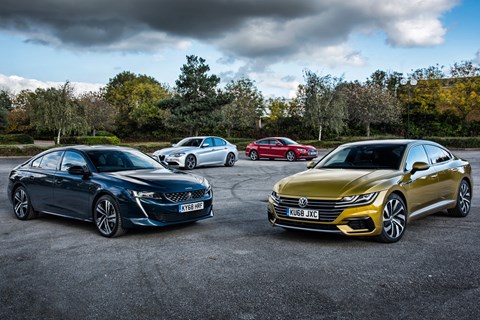
First published 03 January 2019
By Jake Groves
For your next company car, should you engage in corporate retreat and fall back from the trad boxy saloon? Which one of these four slick compact execs should you get instead?
Going back to the drawing board…
Peugeot 508
Peugeot really is on a roll – the new 508 is thoroughly un-boring to look at. It’s extremely handsome even in ‘don’t look at me’ blue with tasty rims and animated rear lights. You have to go GT-Line or GT (like this one) to get those sabre-tooth DRLs.
Alfa Romeo Giulia
Still a real looker, even in a sober colour and trim. It’s all about curves, in stark contrast to the other three, with their angles and lines. Giulia’s shape is cohesive, classically Italian and not-actually-that-saloon-like. Molto, molto bene.
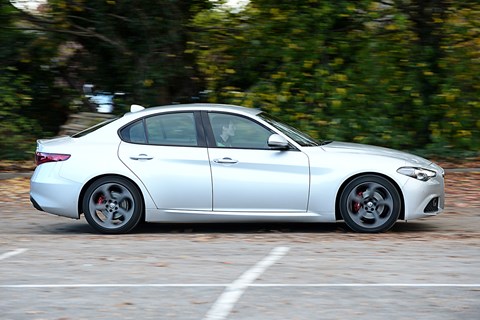
Audi A5 Sportback
Familiar shape that will make some nod in quiet approval at the crisp lines and clean surfaces, while others will reach for the Red Bull to help them stay awake. Ours is not in one of Audi’s 400,000 different shades of grey. Hooray?
VW Arteon
Who’d have thought a modern-day VW exec car could get any attention in the office car park? Brash grille, Spirograph alloys and sharp beltline hide its plain Passat undergarments, with details only enhanced by the korma yellow paintwork.
Does it really move the needle?
Peugeot 508
Top-end GT’s only diesel is a 178bhp BlueHDi that feels pokey, particularly when riding the torque wave, but engine noise when accelerating is more intrusive than the VW’s. Unobtrusive EAT8 auto ‘box is extremely smooth, with Sport mode jolting some life into it.
Alfa Romeo Giulia
Engine willingly lets you know that it’s a diesel, and quite a gruff one at that. Punchy delivery, though, with a smooth whump of torque to exploit via the eight-speed ZF and its gorgeous metal paddles. Manual changes in Dynamic are a little lurchy but you’ll be having too much fun to care.
Audi A5 Sportback
Pretty much the same engine as the golden Volkswagen but the Audi runs slightly different mapping, to help bring the torque in earlier, and is slightly quicker on paper. It’s also available in the supposedly thriftier Ultra version.
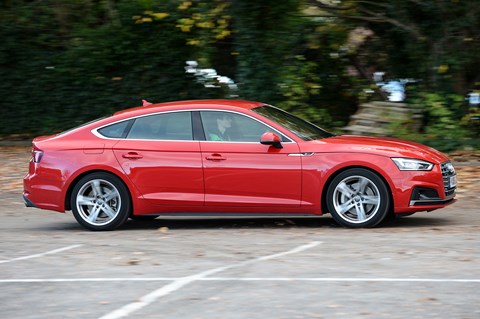
VW Arteon
There’s more power than the Alfa and 508 but that doesn’t translate into particularly sprightly performance, with the torque flatter than the Peugeot in particular. Oomph from low-gear, heavy-foot cornering is neutered by hyperactive traction control. Boo.
Can it go the extra mile?
Peugeot 508
Active suspension kills bodyroll in Sport but can get wallowy in Comfort. It’s a little louder at motorway speeds than the VW Group pair and the GT’s big wheels make some potholes a little spikey. Steering via teeny wheel is precise and progressive.
Alfa Romeo Giulia
Steering is among the best on the market, and just as lively as the hotter QF version. Ride strikes a great balance between killing bodyroll and not making ruts too much of a fuss. Adaptive dampers can be in their ‘soft’ setting even in Dynamic mode. Brakes are strong, too.
Audi A5 Sportback
This one has no-cost-option Comfort suspension (Sport set-up is default) to help stave off some lumps but feels no softer than Alfa and 508. The progressive steering has a dead spot at centre and S-tronic gearbox ponders the odd hard acceleration shift. It’s the most refined on the motorway, though.
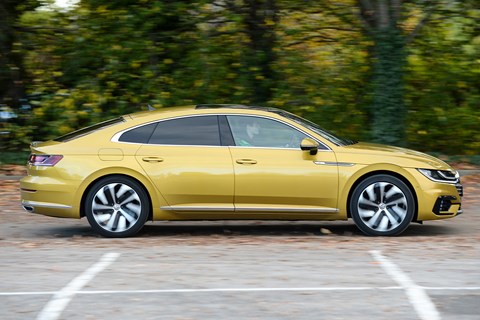
VW Arteon
It’s almost as hushed on the move as the Audi due to optional double glazing, but bigger wheels make more noise and tell you more about the road surface. Steering is mildly less dead than Audi and it corners flatter. Dynamic Chassis Control modes don’t make a lot of difference.
Pushing the interior design envelope past the sticky bit?
Peugeot 508
Even for Peugeot this is ultra-modern and, unlike French stereotypes, well built. Cockpit has high instrument cluster with crisp graphics, and the centre console hides USBs and wireless charger. Usual PSA infotainment is still fiddly.
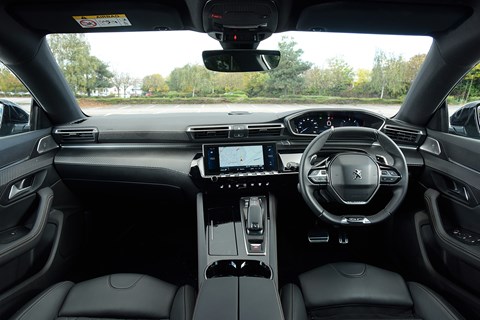
Alfa Romeo Giulia
Driving position is proper sports car fare and most of the materials are fine, but ours had wobbly dials and a sticky cupholder cover. It doesn’t help that infotainment is both complicated to navigate and has the resolution of a potato.
Audi A5 Sportback
Getting on a bit compared to the futuristic Peugeot, but still well built and ergonomically sound. Blocky gear selector, perforated leather wheel and metal door handles are sweet. Buy now before Audi kills the handy rotary.
VW Arteon
And we’re back in a Passat! Plainest interior here with sporty wheel and stretching air vent the only real interesting bits. Optional ergoComfort seats have active lumbar supports and carbonfibre-effect upholstery.
I need to touch base with colleagues…
Peugeot 508
Fastback rear cuts into headroom for the tallest of your corporate associates but legroom is good, while boot is larger than in the Audi and Alfa. Powered tailgate has hands-free function, while optional night vision will help you stop running folk over after office hours.
Alfa Romeo Giulia
If you can get in through the narrow doors, legroom and headroom are good, but shallow windows and roof-to-floor black inside may induce claustrophobia. It’s the only proper saloon here, so boot access aperture is smaller, but it’s on a par for space with the Audi.
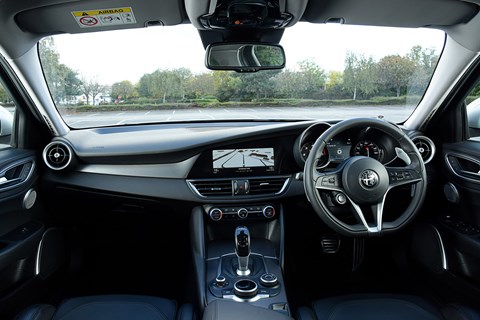
Audi A5 Sportback
Supportive but firm seating all around is upholstered in half velour-like materials, with legroom tighter but headroom more generous than the Peugeot. The boot has the same volume as the Giulia, but access is naturally better here due to hatchback rear.
VW Arteon
Then this is the car to do it in. So much room in the back you could host your own sales conference, but skip the sunroof to maximise head space. Boot is also the largest here, which is almost as capacious as an Audi A6 Avant’s by volume.
Let’s crunch the numbers…
Peugeot 508
Just behind the Germans for claimed mpg and goes toe-to-toe with them in terms of residual values, thanks to Peugeot’s new tactic of not flooding its dealers with OTT ex-demos. Three-year/60,000-mile costs are 55.6ppm. Get one for £316pm**, or £441pm** in this spec.
Peugeot 508 leasing deals
Alfa Romeo Giulia
Alfa has introduced an updated diesel for the 2019 model year to pass Euro 6d-Temp emissions regs. New engine gains 9bhp (up to 186bhp) but economy is worse by 10mpg. Still the cheapest per mile to run at 51.2ppm, and you can lease one for around £345pm**. Bargain.
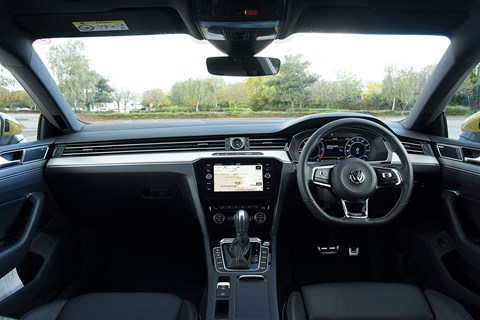
Alfa Giulia leasing deals
Audi A5 Sportback
A5 remains competitive, with similar overall running costs at 55.3ppm if you get one with the Technology Pack, and it has the best claimed fuel economy (tied with the VW). Just be careful not to go overboard on additional options. A £584pm** lease offer is a lot more than the others.
Audi A5 Sportback leasing deals
VW Arteon
The most expensive to run over three years, at 55.8ppm. It’s the cheapest to lease out of the four at £312pm** mind, and is in a lower insurance group than the Audi and 508. There are both ups and downs here – just like the thumb positions of passers-by.
VW Arteon leasing deals
Verdict
WINNER – Peugeot 508: ★★★★
A stunner inside and out, and now a real contender.
Alfa Romeo Giulia: ★★★★
The driver’s choice for those who don’t sweat the small stuff.
Volkswagen Arteon: ★★★
Practical and striking, but a sheep in wolf’s clothing.
Audi A5 Sportback: ★★★
Classic and refined, but roundly outshone here.
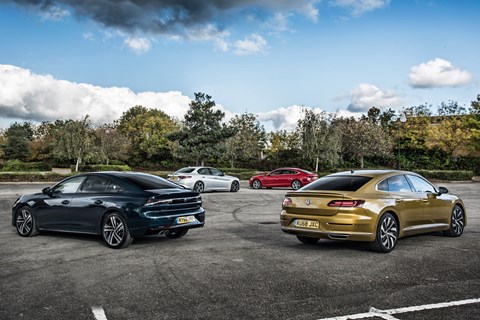
Best compact executive: specifications
Peugeot 508 GT BlueHDi 180 auto
Price £36,400 (£38,875 as tested)
Engine 1997cc 16v turbodiesel 4-cyl, 177bhp @ 3750rpm, 295lb ft @ 2000rpm Transmission 8-speed auto, front-wheel drive
Performance 8.3sec 0-62mph, 146mph, 60.1mpg, 124g/km CO2
Weight 1535kg
Example insurance quote* £664.74
On sale Now
Alfa Romeo Giulia Diesel Super
Price £33,315 (£41,285 as tested)
Engine 2143cc 16v turbodiesel 4-cyl, 177bhp @ 3750rpm, 332lb ft @ 1750rpm Transmission 8-speed auto, rear-wheel drive
Performance 7.1sec 0-62mph, 143mph, 67.3mpg, 109g/km CO2
Weight 1445kg
Example insurance quote* £667.79
On sale Now
Audi A5 S line TDI 190 quattro
Price £41,210 (£46,670 as tested)
Engine 1968cc 16v turbodiesel 4-cyl, 187bhp @ 3800rpm, 295lb ft @ 1750rpm Transmission 7-speed dual-clutch auto, all-wheel drive
Performance 7.4sec 0-62mph, 146mph, 61.4mpg, 121g/km CO2
Weight 1600kg
Example insurance quote* £684.28
On sale Now
VW Arteon R-Line 2.0 TDI 190 DSG
Price £36,180 (£45,350 as tested)
Engine 1968cc 16v turbodiesel 4-cyl, 187bhp @ 3500rpm, 295lb ft @ 1900rpm Transmission 7-speed dual-clutch auto, front-wheel drive
Performance 8.0sec 0-62mph, 148mph, 61.4mpg, 121g/km CO2
Weight 1651kg
Example insurance quote* £680.25
On sale Now
*Insurance quotes are from mustard.co.uk and are based on a 43-year-old employed, married male living in Stowmarket with nine years’ NCD and no claims or convictions. Insurance quotes will vary depending on individual circumstances.
**Lease rates correct at time of writing and found through Parkers’ leasing broker search function for a personal contract hire deal with a nine-month initial prepayment over three years with an annual mileage limit of 10,000 miles.
Check out more of our best car lists here